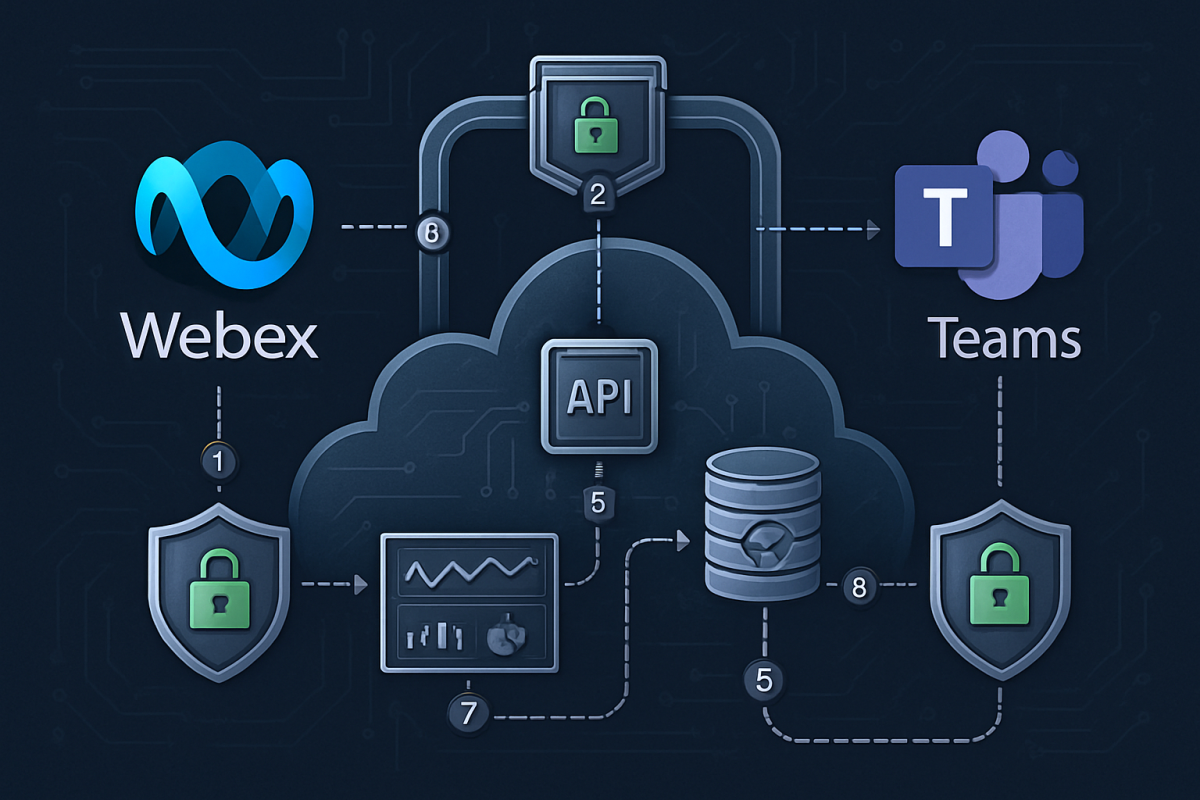The modern workplace demands seamless communication and collaboration tools that work together harmoniously. With 75% of leaders reporting that teams using AI collaborate better and organizations increasingly adopting hybrid work models, the integration of Webex and Microsoft Teams has become essential for maximizing productivity. This comprehensive guide explores eight critical best practices for successfully implementing Webex and Microsoft Teams integration in your organization.
As unified communications platforms continue to evolve, businesses need solutions that bridge the gap between different collaboration ecosystems. Whether your organization uses both platforms due to mergers, acquisitions, or diverse user preferences with 97% of tech companies now offering work location flexibility, implementing these eight best practices will ensure smooth operations and enhanced collaboration across your entire workforce.
1. Conduct Strategic Assessment and Planning
Before diving into technical implementation, successful Webex and Microsoft Teams integration requires thorough strategic planning that aligns with your organization's broader communication objectives. This foundational step sets the stage for all subsequent integration efforts and ensures that your investment delivers meaningful business value.
Assess Your Current Communication Landscape
Understanding your existing communication infrastructure is crucial for successful integration. Conduct a comprehensive audit of your current tools, identifying which teams use Webex, which prefer Microsoft Teams, and where communication gaps exist. Document your organization's specific use cases, from daily team collaboration to large-scale video conferencing needs.
Consider the unique strengths each platform brings to your organization. Microsoft Teams excels in document collaboration and integration with Office 365 applications, while Webex offers robust video conferencing capabilities and enterprise-grade security features. Your assessment should identify how these complementary strengths can work together to enhance overall productivity.
Map your organizational structure to understand communication patterns between departments, regions, and external partners. This analysis helps determine which integration approaches will deliver the most value and where potential resistance might occur during implementation.
Define Clear Integration Objectives
Establish specific, measurable goals for your Webex and Microsoft Teams integration project. These objectives might include reducing communication silos, improving cross-platform collaboration, or streamlining video conferencing across different user groups. Clear objectives provide direction for technical decisions and help measure success post-implementation. Organizations that properly measure internal communication ROI often see significant returns through reduced time spent searching for resources and improved change management processes.
Consider both short-term and long-term goals in your planning process. Short-term objectives might focus on basic interoperability, while long-term goals could encompass advanced features like unified analytics and single sign-on capabilities. This phased approach allows for gradual adoption and continuous improvement.
Involve key stakeholders from different departments in the objective-setting process to ensure your integration strategy addresses diverse organizational needs. Their input helps identify critical success factors and potential challenges that might not be apparent from a purely technical perspective.
2. Design Intuitive User Experience Workflows
Creating a seamless user experience is paramount when implementing Webex and Microsoft Teams integration. Users should feel empowered rather than hindered by the integration, with intuitive workflows that enhance their daily productivity rather than adding complexity to their communication routines.
Simplify Cross-Platform Navigation
Design integration workflows that minimize the number of steps required for users to access features across both platforms. Users should be able to initiate Webex meetings from within Microsoft Teams or access Teams channels from Webex environments without complex authentication processes or multiple application launches.
Implement single sign-on (SSO) capabilities wherever possible to eliminate password fatigue and reduce security risks. SSO not only improves user experience but also strengthens security by centralizing authentication controls and reducing the likelihood of weak password practices across multiple platforms.
Consider the natural workflows of different user groups within your organization. Sales teams might need quick access to customer video calls, while project managers require seamless document collaboration. Tailoring integration approaches to specific user needs ensures higher adoption rates and greater overall satisfaction.
Provide Consistent Branding and Interface Elements
Maintain visual consistency across integrated platforms to reduce cognitive load on users. When possible, customize interface elements to reflect your organization's branding while preserving the functional benefits of each platform's native design principles.
Develop clear visual cues that help users understand when they're working within integrated environments versus native platform features. This transparency builds user confidence and reduces confusion that can lead to productivity losses or support requests.
Create standardized workflows for common tasks that span both platforms, such as scheduling meetings, sharing documents, or initiating video calls. Consistency in these everyday actions helps users develop muscle memory and reduces the learning curve associated with integration.
3. Establish Comprehensive Security Frameworks
Security considerations are critical when integrating Webex and Microsoft Teams, particularly for organizations handling sensitive data or operating in regulated industries. A comprehensive security strategy addresses both platforms' individual security features and the unique risks that arise from integration.
Implement Unified Security Policies
Develop security policies that address both platforms holistically rather than treating them as separate systems. This approach ensures consistent security postures across your communication ecosystem and prevents gaps that could be exploited by malicious actors. Consider how data flows between platforms and implement appropriate controls at each integration point.
Establish clear governance frameworks for user access management across both platforms. Users should have appropriate permissions in each system based on their roles and responsibilities, with regular reviews to ensure access remains appropriate as organizational needs change.
Consider the implications of data residency and privacy regulations for your integrated environment. Ensure that sensitive data is handled appropriately regardless of which platform it originates from or travels through during normal business operations.
4. Implement Robust Monitoring and Auditing
Comprehensive oversight of your integrated environment ensures security compliance and helps identify optimization opportunities before they become problematic.
Monitor and Audit Cross-Platform Activities
Implement comprehensive logging and monitoring solutions that track user activities across both Webex and Microsoft Teams environments. This visibility is essential for security incident response and compliance reporting requirements that your organization may face.
Develop automated alerts for suspicious activities that span both platforms, such as unusual data access patterns or attempts to escalate privileges across systems. Early detection of potential security issues helps minimize damage and demonstrates due diligence to regulatory bodies.
Regular security audits should include assessment of integration points and data flows between platforms. These reviews help identify potential vulnerabilities introduced by integration and ensure that security controls remain effective as both platforms evolve.

5. Execute Technical Integration with Excellence
The technical foundation of your Webex and Microsoft Teams integration determines its long-term success and reliability. Proper implementation requires careful attention to API management, data synchronization, and system performance optimization.
Leverage Official Integration Options
Prioritize officially supported integration methods whenever possible, as these approaches typically offer better stability, security, and ongoing support from platform vendors. Both Cisco and Microsoft provide documented integration pathways that should form the foundation of your implementation strategy.
The Webex Meetings integration with Microsoft Teams allows users to schedule and join Webex meetings directly from the Teams interface, providing a seamless experience for organizations using both platforms. This integration supports features like one-button push to join meetings and unified meeting notifications.
For more advanced integration needs, consider Webex Video Integration for Microsoft Teams, which enables Cisco and other SIP-capable video devices to join Microsoft Teams meetings with enhanced functionality including multi-screen support and bi-directional content sharing.
Optimize Performance and Reliability
Design your integration architecture with redundancy and failover capabilities to ensure business continuity even when individual components experience issues. This approach is particularly important for organizations where communication platform availability directly impacts business operations.
Implement appropriate caching and data synchronization strategies to minimize latency and improve user experience. Users should not experience significant delays when moving between platforms or accessing integrated features, as these delays can undermine adoption and productivity.
Monitor system performance continuously and establish baseline metrics for integrated functionality. Regular performance reviews help identify optimization opportunities and ensure that integration overhead doesn't negatively impact core platform functionality.
6. Develop Strategic Change Management Programs
Successful integration extends beyond technical implementation to encompass comprehensive change management that helps users embrace new workflows and capabilities. Organizations that invest in proper change management see significantly higher adoption rates and better return on investment from their integration projects.
Create Role-Specific Training Materials
Create role-specific training materials that address the unique needs of different user groups within your organization. Executives may need brief overviews of enhanced collaboration capabilities, while power users require detailed technical training on advanced integration features.
 Implement a phased training approach that begins with basic integration concepts and gradually introduces more advanced features as users become comfortable with fundamental workflows. This progressive approach prevents information overload and allows users to build confidence gradually.
Implement a phased training approach that begins with basic integration concepts and gradually introduces more advanced features as users become comfortable with fundamental workflows. This progressive approach prevents information overload and allows users to build confidence gradually.
Consider multiple training modalities including live sessions, recorded tutorials, and hands-on workshops to accommodate different learning preferences. Some users learn best through experimentation, while others prefer structured instruction or peer-to-peer learning opportunities.
7. Build Champion Networks for User Adoption
Establishing internal advocates and support systems accelerates adoption and helps address real-world implementation challenges that formal training programs might miss.
Establish Champion Networks
Identify enthusiastic early adopters within your organization who can serve as integration champions and peer support resources. These champions help bridge the gap between formal training programs and real-world application challenges that users encounter in their daily work.
Provide champions with additional training and resources so they can effectively support their colleagues during the transition period. Champion networks are particularly valuable for addressing integration-specific questions that general IT support teams may not be equipped to handle initially.
Recognize and celebrate success stories from champion users to build momentum and demonstrate the practical benefits of integration to skeptical users. Real-world examples of improved productivity and collaboration are often more persuasive than theoretical benefits.
8. Maintain Continuous Optimization and Updates
Webex and Microsoft Teams integration is not a one-time implementation but rather an ongoing process that requires regular attention and optimization. Both platforms continue to evolve rapidly, introducing new features and capabilities that may enhance or complicate existing integrations.
Monitor Platform Updates and New Features
Establish processes for tracking updates from both Cisco and Microsoft that may impact your integration implementation. Platform vendors regularly release new features, security updates, and API changes that could enhance integration capabilities or require adjustments to existing configurations.
Develop testing procedures for evaluating platform updates before deploying them to production environments. This testing should include verification of integration functionality and assessment of any new capabilities that could benefit your users.
Create change management processes that help users take advantage of new integration features as they become available. Regular communication about platform enhancements helps maintain user engagement and ensures that your organization maximizes the value of its integration investment.
Gather and Act on User Feedback
Implement systematic feedback collection mechanisms that capture user experiences with integrated workflows. This feedback helps identify pain points, optimization opportunities, and new use cases that weren't apparent during initial implementation.
Regular user surveys and focus groups provide valuable insights into how integration is actually being used versus how it was intended to be used. These insights often reveal opportunities for additional customization or training that can significantly improve user satisfaction and productivity.
Establish processes for rapidly addressing common user issues and requests for enhancement. Quick responses to user feedback demonstrate organizational commitment to successful integration and encourage continued engagement with new features and capabilities.
Transform Your Communication Strategy Today
Successfully integrating Webex and Microsoft Teams requires careful planning, strategic implementation, and ongoing optimization. By following these eight best practices, organizations can create seamless communication experiences that leverage the strengths of both platforms while minimizing complexity for users.
The investment in proper integration planning and implementation pays dividends through improved collaboration, reduced communication silos, and enhanced productivity across your organization. As hybrid work models continue to evolve and communication requirements become increasingly sophisticated, integrated platforms provide the flexibility and functionality that modern businesses demand.
Ready to optimize your organization's communication infrastructure? Discover how Pure IP’s comprehensive cloud-based voice solutions can seamlessly integrate with your existing collaboration platforms, providing the reliability, security, and advanced features your business needs to thrive in today's digital workplace.





